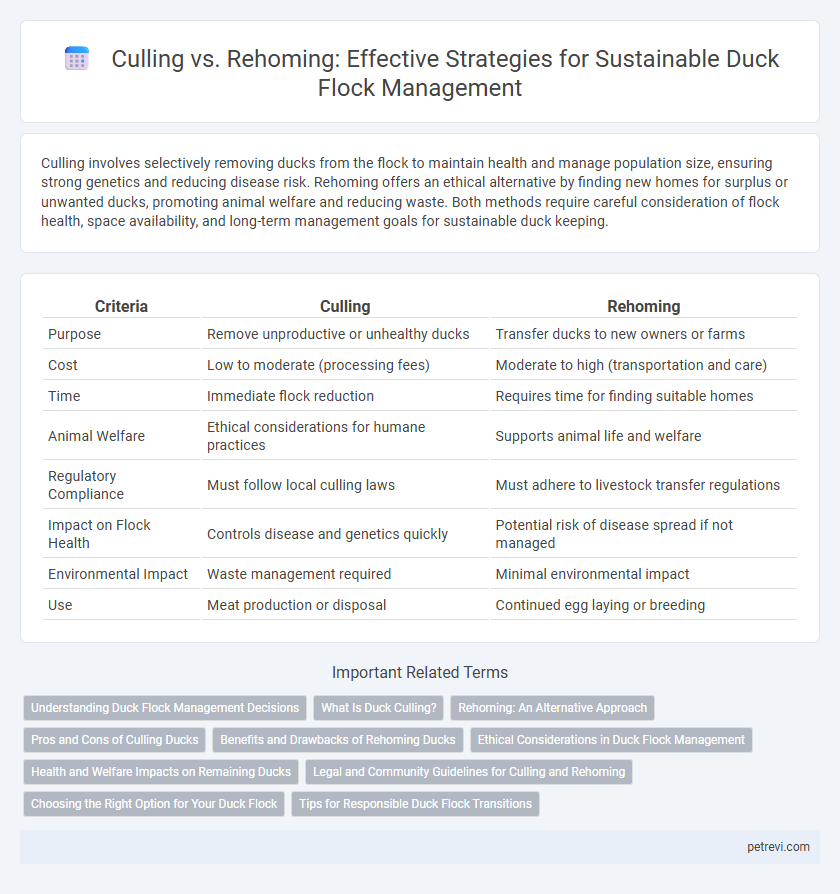Culling involves selectively removing ducks from the flock to maintain health and manage population size, ensuring strong genetics and reducing disease risk. Rehoming offers an ethical alternative by finding new homes for surplus or unwanted ducks, promoting animal welfare and reducing waste. Both methods require careful consideration of flock health, space availability, and long-term management goals for sustainable duck keeping.
Table of Comparison
| Criteria | Culling | Rehoming |
|---|---|---|
| Purpose | Remove unproductive or unhealthy ducks | Transfer ducks to new owners or farms |
| Cost | Low to moderate (processing fees) | Moderate to high (transportation and care) |
| Time | Immediate flock reduction | Requires time for finding suitable homes |
| Animal Welfare | Ethical considerations for humane practices | Supports animal life and welfare |
| Regulatory Compliance | Must follow local culling laws | Must adhere to livestock transfer regulations |
| Impact on Flock Health | Controls disease and genetics quickly | Potential risk of disease spread if not managed |
| Environmental Impact | Waste management required | Minimal environmental impact |
| Use | Meat production or disposal | Continued egg laying or breeding |
Understanding Duck Flock Management Decisions
Effective duck flock management involves carefully weighing the benefits of culling versus rehoming to maintain flock health and productivity. Culling targets removing sick or underperforming ducks to prevent disease spread, enhance genetic quality, and optimize resource use. Rehoming offers a humane alternative by relocating healthy or surplus ducks, promoting animal welfare while managing flock size and reducing operational costs.
What Is Duck Culling?
Duck culling involves selectively removing ducks from a flock to maintain optimal health, control population size, and improve overall flock quality. This practice targets sick, injured, or underperforming ducks to prevent disease spread and enhance resource allocation. Effective culling supports sustainable flock management by promoting stronger genetic traits and reducing overcrowding.
Rehoming: An Alternative Approach
Rehoming offers a sustainable alternative to culling in duck flock management, preserving animal welfare and reducing environmental impact. By transferring ducks to new homes or sanctuaries, farmers support biodiversity and promote ethical treatment of animals. This practice also helps maintain flock genetics and supports community-based agricultural initiatives.
Pros and Cons of Culling Ducks
Culling ducks in flock management efficiently controls population size and reduces the risk of disease spread, enhancing overall flock health and productivity. However, culling can lead to ethical concerns and potential emotional distress for caretakers, while also risking the loss of genetic diversity. This method allows for rapid flock size adjustment but may impact long-term sustainability if not balanced with rehoming strategies.
Benefits and Drawbacks of Rehoming Ducks
Rehoming ducks offers benefits such as reducing flock size without culling, promoting animal welfare, and providing ducks with potentially better living conditions by new owners. However, drawbacks include the risk of poor care in unfamiliar environments, potential disease transmission, and the challenge of finding responsible adopters committed to long-term care. Effective rehoming requires thorough vetting and clear communication to ensure ducks' well-being and minimize stress during the transition.
Ethical Considerations in Duck Flock Management
Culling in duck flock management involves selective removal to maintain health and productivity, but it raises ethical concerns about animal welfare and stress. Rehoming offers a compassionate alternative by placing ducks in suitable environments, promoting natural behaviors and extended care. Prioritizing rehoming supports ethical stewardship, balancing flock management needs with respect for duck well-being.
Health and Welfare Impacts on Remaining Ducks
Culling in duck flock management reduces disease transmission by removing sick or weak individuals, which helps maintain overall flock health and reduces stress among surviving ducks. Rehoming preserves the flock population but can introduce stress and increase the risk of disease spread if new ducks carry pathogens or if the process disrupts social structures. Prioritizing health monitoring and quarantine measures maximizes welfare outcomes regardless of the chosen strategy.
Legal and Community Guidelines for Culling and Rehoming
Culling ducks requires strict adherence to local legal regulations and animal welfare standards to avoid penalties and ensure humane practices, with many jurisdictions mandating licensed personnel and approved methods. Rehoming ducks must comply with community guidelines that often include health certifications, quarantine protocols, and restrictions on transferring animals across certain regions to prevent disease spread. Understanding and following these legal and community frameworks helps maintain ethical flock management while safeguarding public health and animal welfare.
Choosing the Right Option for Your Duck Flock
Culling reduces disease risk and maintains flock health by removing weaker or sick ducks, ensuring stronger genetic stock and optimal resource allocation. Rehoming supports ethical treatment and allows ducks to live in less intensive environments, often improving overall welfare but requiring careful selection of suitable homes. Balancing culling and rehoming strategies depends on flock size, health status, and long-term management goals to optimize sustainability and animal welfare.
Tips for Responsible Duck Flock Transitions
Culling helps maintain a healthy duck flock by removing ill or unproductive birds, preventing disease spread and overcrowding. Rehoming offers a humane alternative, ensuring ducks find suitable new environments while reducing flock stress. Prioritize clear health assessments, proper transport methods, and ethical decision-making to support responsible duck flock transitions.
Culling vs Rehoming for Duck flock management Infographic

 petrevi.com
petrevi.com